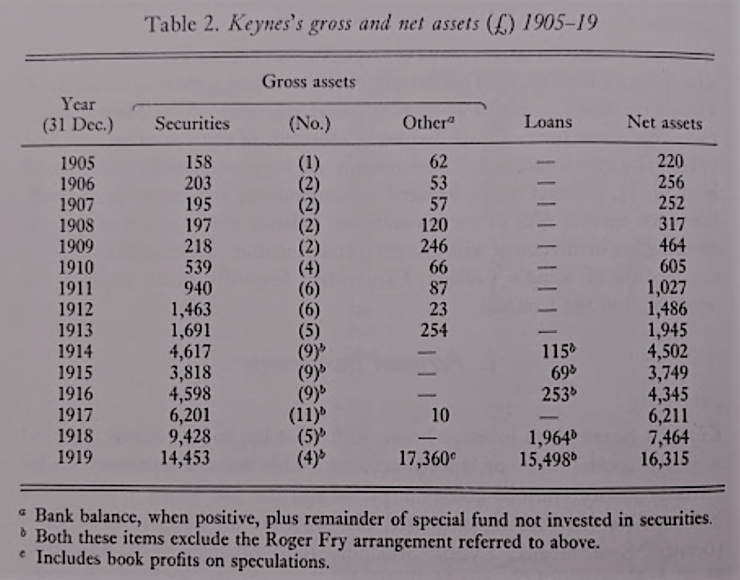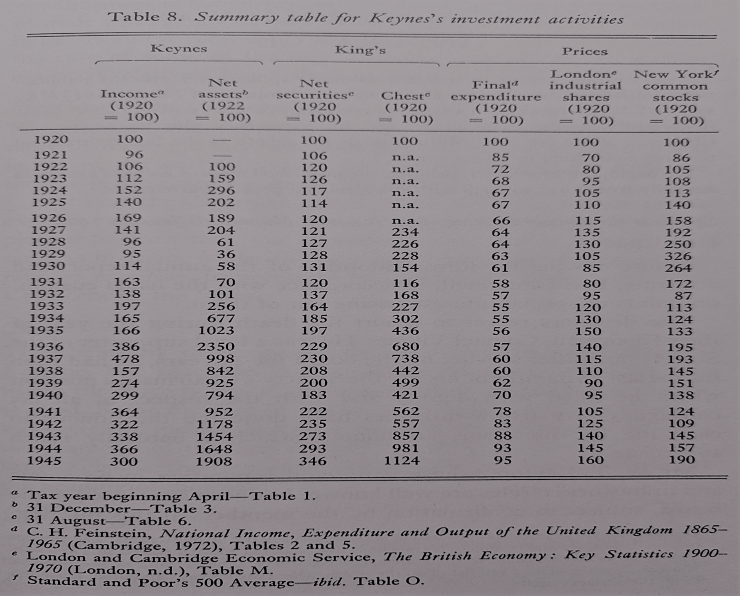Most people know John Maynard Keynes the economist. Not many know Keynes the investor. The track record of his personal accounts and the King’s College Chest Fund show he was a decent, though risk-averse, investor.
One thing stands out when you compare the two records. He consistently used margin loans in his personal accounts. I wanted to take a deeper dive into the impact margin loans had on his results.
For those not aware, a margin loan is borrowed money used to buy securities in an attempt to juice returns. The results can be exceptional if things go right or horrendous when things go wrong.
When you borrow money against an asset, and the value of the asset falls, bad things can happen. The main reason is due to minimum margin requirements. Lenders don’t like to lose money any more than we do, so minimum margin requirements help safeguard lenders from losses.
But it doesn’t protect you from losses. In fact, the minimums do the opposite whenever it’s triggered. Because you’re hit with a margin call.
A margin call basically says, your margin loan is too high (as a percentage of your brokerage account’s total value). You need to lower it. So you either scramble to come up with more money to put into your account or you’re forced to sell the stocks you bought with the loan. Forced selling is the likely and worst-case scenario because the selling is done at a loss.
Keynes talks about being forced to sell shares because of margin calls several times. The only thing worse than selling out of fear after a sharp decline is being forced to do it. At times, Keynes was forced to take huge losses, while knowing he likely sold near the bottom too. It was like rubbing salt in a wound.
To give you a better idea of what he dealt with, I snapped a couple of images showing his record from 1905 to 1945. Keep in mind, this doesn’t account for any money being added or removed in any given year. It just shows the change in security value and net asset value from year to year. So it’s not a perfect picture of his annual returns. But I think it offers a rough idea of the type of big swings his investment strategy produced.


A couple of quick points before moving on:
- Once Keynes started on margin, he was hooked. Whether it was some internal need to get rich quick, I don’t know, but it seems like it. He fully experienced the joys and pains that came with it.
- Over the entire period, Keynes played in the UK stock market, the US stock market, commodities, and currencies. He had no problem having half his portfolio or more in borrowed money.
- The big hit in 1920 completely wiped him out. He was in the hole, plus owed money to friends and family shown in the footnote of Table 3. He borrowed more from friends and family to stay in the game. It took him two years to get back to even and repay everyone. And he did it the same way he lost it, by speculating on margin, mostly in currencies and commodities.
- In 1934, there was a drastic increase in the number of securities held. Don’t let the numbers fool you. Keynes preferred a concentrated portfolio. Even though the total number of securities increased, a small number — roughly 3 or 4 — consistently made up half his portfolio.
His overall results were described this way:
The first thing that strikes one…is that he was not uniformly successful as an investor. In the 1920s, for example, in five of the seven years between 1922 and 1929 Keynes did worse than the Bankers’ Magazine index. On the other hand, in the years after 1929, his investments outperformed the market in 21 of 30 accounting years and did so cumulatively by a large margin. As well, the figures indicate that he was much more likely to beat the market when it was rising. From the detailed records available, it is also clear that he was an extremely active investor… More often than not, especially after the late 1920s, the securities of a few firms would dominate Keynes’s portfolio.
The combination of margin loans, a concentrated portfolio, and illiquid currency and commodity investments provided the boost he wanted when markets were rising. For the same reasons, he suffered more when markets fell.
So the question is: Is following a similar strategy worth it? I guarantee a bunch of people will gaze at the last line of the last table and say absolutely. Keynes died wealthy, so of course, it’s worth it.
But the two tables are just a snapshot of the year-end results. He invested through two World Wars and a U.S. Depression that reached across the globe. Yet, his entire experience is missing. The highs and lows of any given year are missing. The daily swings, week after week, every year for forty years aren’t there. Which securities he owned, how much of each, the ones he was forced to sell, and other decisions he made because of all of it are missing.
Unfortunately, there’s no way to show any of it. So the table below showing the percentage change in value will have to do.

I color-coded the results and I highlighted the worst years in bold, for those who can’t look past the green spaces.
Yes, things turned out all right for the guy. But there was a bust and at least one close call.
1920 was the worst year. He lost more than everything, ending at £1,837 in the hole (not counting the £6,750 in “moral debts” he owed). Luckily friends and family bailed him out and kept him in the game.
The five-year stretch starting in 1925 was rough. 1925 hit him with a 32% loss. 1928 cut his assets again with a 70% loss. 1929 cut it again with a 40% loss. How many investors would be left in the fetal position after that five-year run? To see your net worth fall by 88% is hard to imagine.
Then nearly a decade later another terrible multi-year run struck again. His net worth fell 66% from 1937 to 1940.
You have to gives Keynes credit, though. The guy had guts. Most people would give up after the first crushing blow. And if they survived the first round, the second would finish them. Not Keynes. He was obviously comfortable with all of it. He had a stubborn optimism and conviction to survive in his style. At the same time, his strategy hints at a need to chase huge wins.
What would his end result look like had he avoided margin altogether? His results with the Chest Fund might offer a clue.

While not being an apples-to-apples comparison, it should give you an idea of the possibilities. Keynes relied on margin, currencies, and commodities in his own account. With the Chest Fund, he used no margin and minimal currency and commodity speculation. The only similarity is the concentration in the portfolio.
Over the 25 year period, the Chest Fund returned 10.2% annually compared to the London index of 1.9% and the New York index of 2.6%. The Chest Fund dealt with 6 losing years:
- 1928 = -3.4%
- 1930 = -32.5%
- 1931 = -24.7%
- 1938 = -40.1% (the worst year)
- 1940 = -15.6%
- 1942 = -0.9%
His best year never went above 56%. So it’s a much smoother result compared to the big swings in his personal account. Looking at his change in net assets as a return (not the best comparison), would get an extremely lumpy 13.7% annually over the 23 years shown.
Given a choice between those two, I doubt many people would be upset about a 10.2% return, given the circumstances. Would an extra 3%, with the additional risk of going bust, really be worth it?
Markets, in the short term, can be unpredictable. Unexpected events pop up often enough that the potential upside earned on margin is outweighed by the possibility of blowing up.
Looking at Keynes’s forty-year personal account, I see risk management pushed aside for higher returns at all costs. A cost Keynes was lucky not to suffer twice. The Chest Fund seems to attempt to do the opposite, with great results, at a much lower risk of going bust.
Source:
The Collected Writings of John Maynard Keynes, Vol. 12
Related Reading:
John Maynard Keynes’s Investment Policy
Lessons from Keynes the Investor
